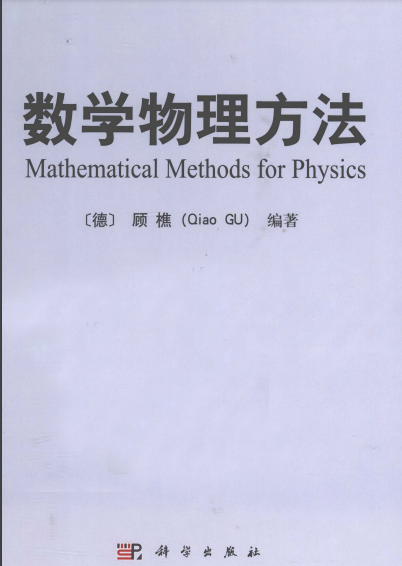第二章 傅里叶级数
傅里叶系数
首先,我们需要知道$sin$和$cos$的正交性,即:
\[\begin{aligned} &\int_0^{2\pi}1\cdot\cos nx\mathrm{d}x=0,\quad\int_0^{2\pi}1\cdot\sin nx\mathrm{d}x=0\\ &\int_0^{2\pi}\cos mx\cdot\cos nx\mathrm{d}x=0,\quad\int_0^{2\pi}\sin mx\cdot\sin nx\mathrm{d}x=0\\ &\int_0^{2\pi}\cos mx\cdot\sin nx\mathrm{d}x=0 \end{aligned}\]这个正交性在后面非常重要。
一个以$2\pi$为周期的函数的傅里叶展开可以写成:
\[f(x)=a_0+\sum_{n=1}^\infty\left(a_n\cos nx+b_n\sin nx\right).\]关键的问题在于其系数的计算,对于$a_0$我们直接开始积分:
\[\begin{aligned} \int_{0}^{2\pi}f(x)\mathrm{d}x& =\int_{0}^{2\pi}\left[a_{0}+\sum_{n=1}^{\infty}\left(a_{n}\cos nx+b_{n}\sin nx\right)\right]\mathrm{d}x \\ &=2\pi a_{0}+\sum_{n=1}^{\infty}a_{n}\underbrace{\int_{0}^{2\pi}\cos nx\mathrm{d}x}_{=0}+\sum_{n=1}^{\infty}b_{n}\underbrace{\int_{0}^{2\pi}\sin nx\mathrm{d}x}_{=0} \\ &=2\pi a_{0} \end{aligned}\]于是乎,$a_0=\frac{1}{2\pi}\int_0^{2\pi}f(x)\mathrm{d}x$。对于后面的系数$a_n,b_n$,直接乘上一个$sinnx,cosnx$,由于不同角速度的项积了分后为零,就只剩下了相同角速度的项。书上的例子是:
\[\begin{aligned} \int_{0}^{2\pi}f(x)\cos mx\mathrm{d}x=& \int_{0}^{2\pi}\cos mx\left[a_{0}+\sum_{n=1}^{\infty}\left(a_{n}\cos nx+b_{n}\sin nx\right)\right]\mathrm{d}x \\ &=a_{0}\underbrace{\int_{0}^{2\pi}\cos mx\mathrm{d}x}_{=0}+\sum_{n=1}^{\infty}b_{n}\underbrace{\int_{0}^{2\pi}\cos mx\sin nx\mathrm{d}x}_{=0} \\ &+\sum_{n=1}^{\infty}a_{n}\int_{0}^{2\pi}\mathrm{cos}mx\cos nx\mathrm{d}x \\ &\left.=\sum_{n=1}^{\infty}a_{n}\left\{\begin{array}{ll}{\pi}&{(m=n)}\\{0}&{(m\neq n)}\\\end{array}\right.\right. \\ &=\pi\sum_{n=1}^{\infty}a_{n}\delta_{mn} \end{aligned}\]其中$\delta_{mn}$就是当$m=n$时为1,其他时候为0。拓展到周期为$L$的函数上面(满足狄利克雷条件),系数的公式就是:
\[\begin{gathered} a_{0}={\frac{1}{2L }} \int_{-L}^{L}f(t)\mathrm{d}t \\ a_{n} =\frac{1}{L}\int_{-L}^{L}f(t)\cos\frac{n\pi}{L}t\mathrm{d}t \\ \boldsymbol{b}_{n} =\frac{1}{L}\int_{-L}^{L}f(t)\sin\frac{n\pi}{L}t\mathrm{d}t \end{gathered}\]半幅傅里叶系数
就是说一个定义域为$(0,L)$的函数,也可以进行傅里叶展开,有两种形式:余弦形式和正弦形式。说白了就是把函数看成偶函数/奇函数,然后进行傅里叶展开。公式如下:
\[\begin{aligned} &\phi(x)=\sum_{n=1}^{\infty}C_{n}\sin\frac{n\pi x}{L}\\ &C_{n}=\frac{2}{L}\int_{0}^{L}\phi(x)\sin\frac{n\pi x}{L}\mathrm{d}x\quad(n=1,2,3,\cdots)\\ &\phi(x)=D_{0}+\sum_{n=1}^{\infty}D_{n}\cos\frac{n\pi x}{L}\\ &D_{0}=\frac{1}{L}\int_{0}^{L}\phi(x)\mathrm{d}x\\ &D_{n}=\frac{2}{L}\int_{0}^{L}\phi(x)\cos\frac{n\pi x}{L}\mathrm{d}x\quad(n=1,2,3,\cdots) \end{aligned}\]傅里叶积分
对于非周期信号也可以进行傅里叶展开。首先,它需要满足绝对可积条件,即:
\[\int_{-\infty}^{\infty}|f(x)|\mathrm{d}x<\infty\]有了绝对可积条件后,傅里叶级数里面$a_0$项就可以写为:
\[a_{0}=\frac{1}{2L}\int_{-L}^{L}f(t)\mathrm{d}t\xrightarrow{L\rightarrow\infty}0\]然后,令$\omega_n=\frac{n\pi}{L}$,则有:
\[\Delta\omega=\omega_{n}-\omega_{n-1}=\frac{\pi}{L}\]然后就可以把求和写成积分:
\[\sum_{n=1}^{\infty}\cdots\Delta\omega\xrightarrow{L\to\infty}\int_{0}^{\infty}\cdots d\omega\]把傅里叶级数改写成积分形式,需要注意的是,这里的改写需要满足绝对可积条件:
\[\begin{aligned} \sum_{n=1}^{\infty}a_{n}\cos{\frac{n\pi}{L }} x& =\sum_{n=1}^{\infty}\frac{1}{L}\left[\int_{-L}^{L}f(t)\cos\frac{n\pi}{L}t\mathrm{d}t\right]\cos\frac{n\pi}{L}x \\ &=\sum_{n=1}^{\infty}\frac{\Delta\omega}{\pi}\left[\int_{-L}^{L}f(t)\cos\omega_{n}t\mathrm{d}t\right]\cos\omega_{n}x\\ &\xrightarrow{L\to\infty}\int_{0}^{\infty}d\omega\left[\frac{1}{\pi}\int_{-\infty}^{\infty}f(t)\cos\omega t\mathrm{d}t\right]\cos\omega x \end{aligned}\]总之,非周期函数的傅里叶积分可以写成如下形式:
\[f(x)=\int_{0}^{\infty}[A(\omega)\cos\omega x+B(\omega)\sin\omega x]\mathrm{d}\omega\]其中:
\[\begin{aligned}A(\omega)&=\frac{1}{\pi}\int_{-\infty}^\infty f(t)\cos\omega t\mathrm{d}t\\B(\omega)&=\frac{1}{\pi}\int_{-\infty}^\infty f(t)\sin\omega t\mathrm{d}t\end{aligned}\]至此,傅里叶积分结束,基本上后面傅里叶变换的形式也就都出来了,下一步主要看它怎么从实数形式改写成复数形式的,在学校的课程中,这一部分基本都一笔带过。
